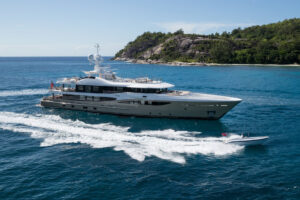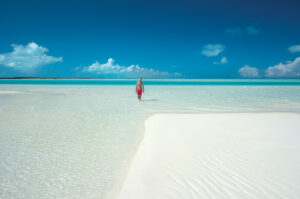The Cotentin Peninsula, part of Normandy in northern France, proudly protrudes into the English Channel, that stretch of water separating Great Britain from its European neighbors. The French call the same body of water La Manche, but call it what you will-it offers the British yachtsman his first opportunity to explore foreign lands. Crossing the channel is as alluring to Brits as heading to the Bahamas from Florida is to us in the States.
At 6 p.m. we set out aboard Sloane Voyager from Buckler’s Hard Marina, on the Beaulieu River tucked inside the Isle of Wight, which guards Britain’s south shores. The channel is 22 miles wide at its narrowest point, but from where we set off, we had 90 miles to sail.
La Manche is one of the world’s busiest waterways, and traffic is directed northbound on the French side and southbound on the British side. Within an hour of our departure, heavy traffic was pouring down from port to starboard. Midway through no one was about, but as dawn began to break, we picked up the lights of the French coast, and the northbound ships were on our starboard bow.
We made landfall on the commercial ferry port of Cherbourg and motored into its majestic harbor, which is protected by massive breakwaters. We hopped ashore and hungrily made our way to the bakery, hurrying past cafés giving off wafts of freshly roasted coffee. We returned to the boat laden with munchies for breakfast: croissants, pain au chocolat, pain au raisin and sticks of French bread so hot and fresh we could hardly hold them.
Saturday is market day in Cherbourg. In towns and cities all over France, these farmers’ markets are an important way of life. New European Union policies regulating the way food is made and sold seem to have bypassed the French. In the provincial markets you can prod and poke at ripening brie cheeses made traditionally, with unpasteurized milk. At the meat stall, you can appraise the skin of a freshly plucked free-range chicken without having to look past a shroud of plastic wrap. Fresh produce is heaped onto tables. The charcoal-burning street barbecues are the nearest the French will likely ever come to creating fast food.
Not all French disapprove of buying foodstuffs in the huge, barn-like stores Americans have grown to love; it’s quite the opposite. In Europe, the French lead the way with “hypermarkets”, department store/supermarket hybrids that combine the size and value of Wal-Mart, the quality of Bloomingdale’s and the selection of some of New York’s best delicatessens. It is because of these hypermarkets that the British flock to this side of the water, and the larger the boats they sail, the better they can take advantage of the prices of food and wine.
While Britain puts heavy duties on wines and sprits, the French consider the consumption of brandy and calvados a way of life and don’t. Little wonder, then, that in this part of France you will find shopkeepers speaking perfect English, eager to help you make your selections. Many offer free delivery to your yacht.
In Cherbourg, we lunched on crêpes, drank locally brewed cider and dined by candlelight. The city was a wonderful first port of call and the perfect way to enter France, but the real crown jewels of the coast lie farther north. Over dinner with our captain we discussed the sailing route and planned our itinerary for the next few days.
The arrival at our next port, Barfleur, required careful planning. This tiny harbor all but dries out at low tide, and securing a quayside berth amidst the local fishing craft on the dock is essential if your vessel needs to stay afloat. Barfleur’s well-preserved church and local museums are well worth a visit. It was from Barfleur that William I, Duke of Normandy, set out to conquer England in 1066. He succeeded, and after ascending the English throne, became known as William the Conqueror. Nearly 1,000 years later, he remains the last person to have landed a successful invading party on Britain’s coast.
The port of St. Vaast is a short trip from Barfleur, and thanks to a clever system of locking gates, the harbor is full of water at all tide stages. The marina, small but well maintained, is a perfect spot to base your boat should crew wish to venture farther inland. The pretty harbor is lined with cafés and useful shops, with little emphasis on tourist tackiness.
The back streets, however, offer the real gems of this tiny town. Shops here, with a style of trading unaltered in decades, appear as though they were pulled from a time capsule. Not merely relics of the past, they are highly successful business ventures superb at offering what locals want: quality produce. Bakeries and fishmongers rub shoulders with butchers and charcuteries, and wine merchants are set beside fashion boutiques. Prince amongst these produce stores is Maison Gosselin, a shop that has been under family control since 1889. Now in the hands of Françoise Gosselin Besselievre, a great-granddaughter of the company’s founder, it encompasses several neighboring stores and is a labyrinth of corridors and specialized sections.
Don’t pass the cheese section without sampling soft and hard cheeses produced by local framers. Eating their cheeses will allow you to deeply enjoy the spectacle that is the wine section, or “cave, stocked with amazing vintages. Some cellars are cordoned off by antique iron gates opened only on request. Crates of bordeaux and burgundy are covered with the dusts of time. Crisp chardonnays sit beside stunning sancerres and honeyed mersaults.
Other areas of this shop are dedicated to cigars and scotch. Through a cunning marketing loophole, Madame Besselievre has managed to import wooden barrels of single-malts directly from distilleries in Scotland’s highlands. Here, the scotch is re-branded, and you can purchase it at a fraction of its typical price, without high taxes. I came here for scotch, of course, but also for French brandy and calvados, a brandy made from apples and named for the region in which originates. I was not disappointed. A gated section of the cellar is a veritable shrine to these liquors. Ask and ye shall taste.
The fortunes of St. Vaast lie in its long, shallow, sloping foreshore, where local oystermen farm oysters on a truly impressive scale. A great way to view these oyster beds is to catch a ride on the “boat-bus. It’s part bus, part boat and makes hourly trips to nearby Tatihou Island, motoring its twin screws at high tide and employing conventional road tires at low. Visitors are rewarded with local stories, pictures and artifacts in a well-maintained museum.
Normandy should be explored slowly to savor its sights and fare. Leave your yacht safely tucked away in the marina and visit the nearby beaches of Omaha, where U.S. forces helped liberate Europe from Hitler during World War II. Not far from there, the inland town of Bayeux houses treasures such as the famous tapestry depicting the Norman Invasion of 1066. The area is packed full of treasures, not just for the gourmet.








